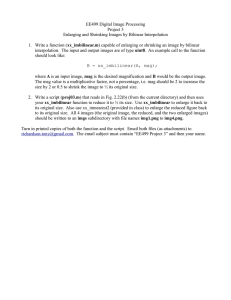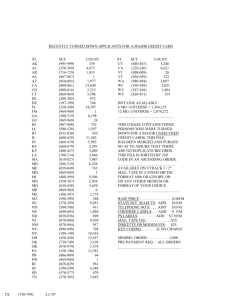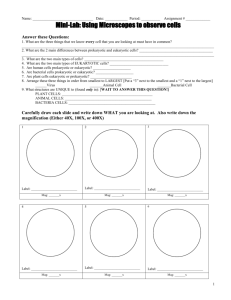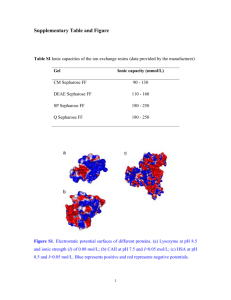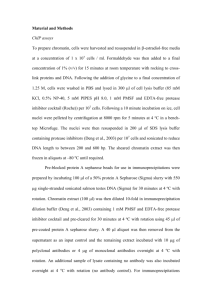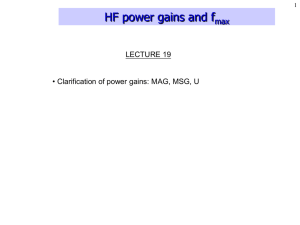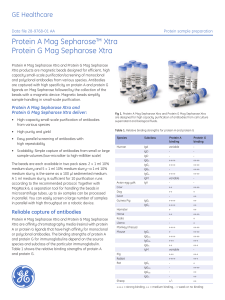Protein A Mag Sepharose™ Xtra Protein G Mag Sepharose Xtra
advertisement
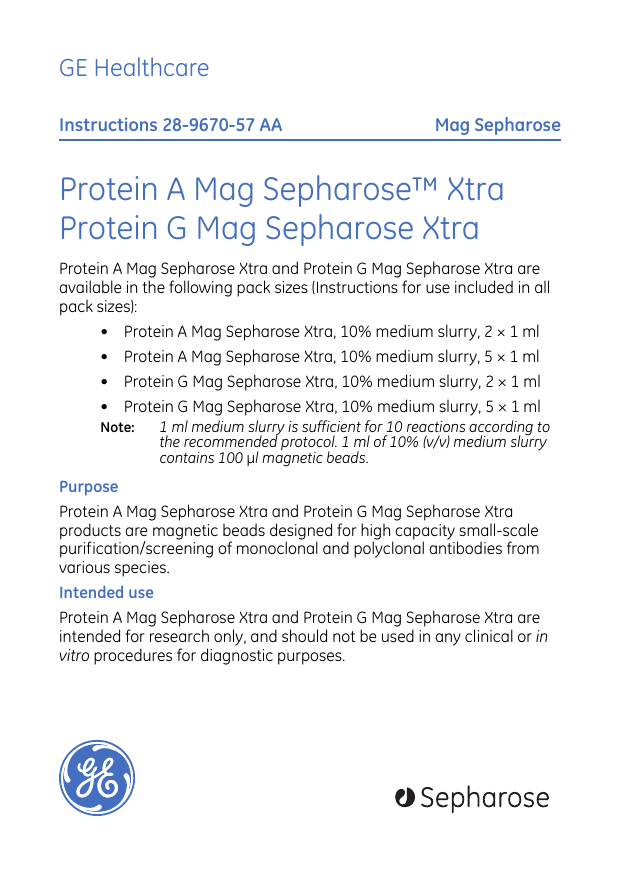
GE Healthcare Instructions 28-9670-57 AA Mag Sepharose Protein A Mag Sepharose™ Xtra Protein G Mag Sepharose Xtra Protein A Mag Sepharose Xtra and Protein G Mag Sepharose Xtra are available in the following pack sizes (Instructions for use included in all pack sizes): • Protein A Mag Sepharose Xtra, 10% medium slurry, 2 × 1 ml • Protein A Mag Sepharose Xtra, 10% medium slurry, 5 × 1 ml • Protein G Mag Sepharose Xtra, 10% medium slurry, 2 × 1 ml • Protein G Mag Sepharose Xtra, 10% medium slurry, 5 × 1 ml Note: 1 ml medium slurry is sufficient for 10 reactions according to the recommended protocol. 1 ml of 10% (v/v) medium slurry contains 100 µl magnetic beads. Purpose Protein A Mag Sepharose Xtra and Protein G Mag Sepharose Xtra products are magnetic beads designed for high capacity small-scale purification/screening of monoclonal and polyclonal antibodies from various species. Intended use Protein A Mag Sepharose Xtra and Protein G Mag Sepharose Xtra are intended for research only, and should not be used in any clinical or in vitro procedures for diagnostic purposes. Table of contents 1 Principle.................................................................................... 3 2 Antibody binding to protein A and protein G.......... 4 3 Advice on handling ............................................................. 5 4 Operation................................................................................. 7 5 Antibody purification protocol....................................... 8 6 Optimization of parameters ........................................... 9 7 Characteristics ................................................................... 10 8 Ordering Information ...................................................... 11 2 28-9670-57 AA 1 Principle Protein A Mag Sepharose Xtra and Protein G Mag Sepharose Xtra are affinity chromatography media with high affinity for antibodies from various species. The media are designed for high capacity, which makes them useful for efficient small-scale purification/screening of monoclonal and polyclonal antibodies. The products are magnetic beads based on Sepharose coupled with protein A or protein G ligands. Protein A Mag Sepharose Xtra and Protein G Mag Sepharose Xtra provide flexible purification allowing a wide range of sample volumes and easy scaling up by varying the bead quantity. Mag Sepharose products can be used together with Eppendorf microcentrifuge tubes and a magnetic rack, for example MagRack 6 (see Section 3 Advice on handling). The magnetic beads are easily separated from the liquid phase during the different steps of the purification protocol. Note: 28-9670-57 AA For immunoprecipitation, it is recommended to use the corresponding products Protein A Mag Sepharose and Protein G Mag Sepharose (see Section 8 Ordering Information). These products have optimized capacities for immunoprecipitation applications. 3 2 Antibody binding to protein A and protein G The binding strengths of protein A and protein G for immunoglobulins depend on the source species and subclass of the particular immunoglobulin. Table 1. Relative binding strengths for protein A and protein G. Species Human Avian egg yolk Cow Dog Goat Guinea pig Hamster Horse Koala Llama Monkey (rhesus) Mouse Pig Rabbit Rat Sheep Subclass IgA IgD IgD IgG1 IgG2 IgG3 IgG4 IgM IgY IgG1 IgG2 IgG1 IgG2a IgG2b IgG3 IgM IgG1 IgG2a IgG2b IgG3 Protein A binding variable ++++ ++++ ++++ variable ++ ++ ++++ ++++ + ++ ++++ + ++++ +++ ++ variable +++ ++++ +/- Protein G binding ++++ ++++ ++++ ++++ ++++ + ++ ++ ++ ++ ++++ + + ++++ ++++ ++++ +++ +++ +++ +++ + ++++ ++ ++ ++ ++++ = strong binding, ++ = medium binding, - = weak or no binding 4 28-9670-57 AA 3 Advice on handling Note: Protein A Mag Sepharose Xtra and Protein G Mag Sepharose Xtra are intended for single use only. General magnetic separation step It is recommended to use 1.5 ml Eppendorf tubes and MagRack 6 in the included protocol (see Section 5). 1 Remove the magnet before adding liquid. 2 Insert the magnet before removing liquid. When using volumes above 1.5 ml, e.g. 50 ml, a magnetic pickpen can be used for collecting the magnetic beads. Another alternative is to spin down the beads by using a swing-out centrifuge. Dispensing the medium slurry • Prior to dispensing the medium slurry, make sure it is homogeneous by vortexing. • When the medium slurry is resuspended, pipette immediately the required amount of medium slurry into the desired tube. • Repeat the resuspension step between each pipetting from the medium slurry vial. 28-9670-57 AA 5 Handling of liquid • Use the magnetic rack with the magnet in place for each liquid removal step. • Before application of liquid, remove the magnet from the magnetic rack. • After addition of liquid, allow resuspension of the beads by vortexing or manual inversion of the tube. When processing multiple samples, manual inversion of the magnetic rack is recommended. Incubation steps • During incubation steps, make sure the magnetic beads are well resuspended and kept in solution by end-over-end mixing or by using a benchtop shaker. • Incubation steps generally take place at room temperature. However, incubation can take place at +4°C over night if this is the recommended storage condition for the specific sample. • When purifying samples of low concentrations or large volumes, an increase of the incubation time might be necessary. • If needed, a pipette can be used to remove liquid from the lid. 6 28-9670-57 AA 4 Operation Recommended buffers Note: Use high-purity water and chemicals for buffer preparation. Table 2. Recommended buffers. Buffer Composition Binding buffer • PBS (137 mM NaCl, 2.7 mM KCl, 100 mM Na2HPO4, 2 mM KH2PO4), pH 7.4 Elution buffer • 100 mM glycine-HCl, pH 2.8 • Protein A Mag Sepharose Xtra and Protein G Mag Sepharose Xtra bind immunoglobulins over a wide pH range and thus permits the use of a variety of buffers. Generally, Protein A Mag Sepharose Xtra and Protein G Mag Sepharose Xtra bind IgG with a strong affinity at pH 7. • Different immunoglobulins elute at different pH values depending on subclass and the species from which they originate. For antibodies sensitive to low pH, optimize elution by determining the highest pH that allows efficient elution. • Suitable buffers can also be easily prepared using Ab Buffer Kit (see Section 8). Sample pretreatment • Check the pH of the sample, and adjust if necessary before applying the sample to the beads. The pH of the sample should equal the pH of the binding buffer. Adjusting the pH could be done by either diluting the sample with binding buffer or by buffer exchange using PD MiniTrap™ G-25 or HiTrap™ Desalting. • Clarification of sample might be needed before applying it to the beads. 28-9670-57 AA 7 5 Antibody purification protocol This protcol is suitable for most antibody purifications. 1 Magnetic bead preparation A Mix the medium slurry thoroughly by vortexing. Dispense 100 µl homogenous medium slurry into an Eppendorf tube. B Place the Eppendorf tube in the magnetic rack, for example MagRack 6 (see Section 3). C Remove the storage solution. 2 Equilibration A Add 500 µl binding buffer. B Resuspend the medium. C Remove the liquid. 3 Sample application A Immediately after equilibration, add 300 µl of sample. If the sample volume is less than 300 µl, dilute to 300 µl with binding buffer. B Resuspend the medium and incubate for 30 minutes with slow end-over-end mixing or by using a benchtop shaker. C Remove the liquid. 4 Washing (perform this step 2 times totally) A Add 500 µl binding buffer. B Resuspend the medium. C Remove the liquid. 5 Elution A Add 100 µl of elution buffer. B Resuspend the medium. C Remove and collect the elution fraction. The collected elution fraction contains the main part of the purified antibody. If desired, repeat the elution. Note: As a safety measure to preserve the activity of acid-labile antibodies, we recommend the addition of 1 M Tris-HCl, pH 9.0, to tubes used for collecting antibody-containing fractions. 8 28-9670-57 AA 6 Optimization of parameters The protocol recommended in this instruction (see Section 5) is suitable for purification of most antibodies. However, some parameters for antibody purification may require optimization to obtain the best result. Examples of parameters which may require optimization are: • Amount of beads • Incubation times • Choice of buffers • Number of washes 28-9670-57 AA 9 7 Characteristics Table 3. Protein A Mag Sepharose Xtra. Matrix Highly crosslinked spherical agarose (Sepharose) including magnetite Medium Protein A coupled NHS activated Mag Sepharose Ligand Protein A Binding capacity >27 mg human IgG/ml gel Particle size 37 to 100 µm Working temperature Room temperature Storage solution 20% ethanol, 10% medium slurry Storage temperature +4°C to +8°C Table 4. Protein G Mag Sepharose Xtra. 10 Matrix Highly crosslinked spherical agarose (Sepharose) including magnetite Medium Protein G coupled NHS activated Mag Sepharose Ligand Protein G Binding capacity >27 mg human IgG/ml gel Particle size 37 to 100 µm Working temperature Room temperature Storage solution 20% ethanol, 10% medium slurry Storage temperature +4°C to +8°C 28-9670-57 AA 8 Ordering Information Products Quantity Code No. Protein A Mag Sepharose Xtra 2 × 1 ml 10% medium slurry 28-9670-56 Protein A Mag Sepharose Xtra 5 × 1 ml 10% medium slurry 28-9670-62 Protein G Mag Sepharose Xtra 2 × 1 ml 10% medium slurry 28-9670-66 Protein G Mag Sepharose Xtra 5 × 1 ml 10% medium slurry 28-9670-70 Related products Quantity MagRack 6 1 Code No. 28-9489-64 Ab Buffer Kit 1 28-9030-59 HiTrap Desalting 5 × 5 ml 17-1408-01 PD MiniTrap G-25 50 columns 28-9180-07 His Mag Sepharose Ni 2 × 1 ml 5% medium slurry 28-9673-88 His Mag Sepharose Ni 5 × 1 ml 5% medium slurry 28-9673-90 Protein A Mag Sepharose 1 × 500 µl 20% medium slurry 28-9440-06 Protein A Mag Sepharose 4 × 500 µl 20% medium slurry 28-9513-78 Protein G Mag Sepharose 1 × 500 µl 20% medium slurry 28-9440-08 Protein G Mag Sepharose 4 × 500 µl 20% medium slurry 28-9513-79 NHS Mag Sepharose 1 × 500 µl 20% medium slurry 28-9440-09 NHS Mag Sepharose 4 × 500 µl 20% medium slurry 28-9513-80 TiO2 Mag Sepharose 1 × 500 µl 20% medium slurry 28-9440-10 TiO2 Mag Sepharose 4 × 500 µl 20% medium slurry 28-9513-77 28-9670-57 AA 11 For local office contact information, visit www.gelifesciences.com/contact GE Healthcare Bio-Sciences AB Björkgatan 30 751 84 Uppsala Sweden www.gelifesciences.com/sampleprep GE Healthcare Europe GmbH Munzinger Strasse 5, D-79111 Freiburg, Germany GE Healthcare UK Ltd Amersham Place Little Chalfont Buckinghamshire, HP7 9NA UK GE Healthcare Bio-Sciences Corp 800 Centennial Avenue P.O. Box 1327 Piscataway, NJ 08855-1327 USA GE Healthcare Japan Corporation Sanken Bldg. 3-25-1, Hyakunincho Shinjuku-ku, Tokyo 169-0073 Japan GE, imagination at work and GE monogram are trademarks of General Electric Company. HiTrap, MiniTrap and Sepharose are trademarks of GE Healthcare companies. All third party trademarks are the property of their respective owners. © 2010 General Electric Company – All rights reserved. First published Apr. 2010. All goods and services are sold subject to the terms and conditions of sale of the company within GE Healthcare which supplies them. A copy of these terms and conditions is available on request. Contact your local GE Healthcare representative for the most current information. imagination at work 28-9670-57 AA 04/2010 Antibody purification protocol This protcol is suitable for most antibody purifications. 1 Magnetic bead preparation A Mix the medium slurry thoroughly by vortexing. Dispense 100 µl homogenous medium slurry into an Eppendorf tube. B Place the Eppendorf tube in the magnetic rack, for example MagRack 6 (see Section 3). C Remove the storage solution. 2 Equilibration A Add 500 µl binding buffer. B Resuspend the medium. C Remove the liquid. 3 Sample application A Immediately after equilibration, add 300 µl of sample. If the sample volume is less than 300 µl, dilute to 300 µl with binding buffer. B Resuspend the medium and incubate for 30 minutes with slow end-over-end mixing or by using a benchtop shaker. C Remove the liquid. 4 Washing (perform this step 2 times totally) A Add 500 µl binding buffer. B Resuspend the medium. C Remove the liquid. 5 Elution A Add 100 µl of elution buffer. B Resuspend the medium. C Remove and collect the elution fraction. The collected elution fraction contains the main part of the purified antibody. If desired, repeat the elution. Note: As a safety measure to preserve the activity of acid-labile antibodies, we recommend the addition of 1 M Tris-HCl, pH 9.0, to tubes used for collecting antibody-containing fractions.
